In early June, a number of Columbus statues in Boston, Houston, Miami, Richmond, and Minnesota were toppled, beheaded, or covered in antiracist slogans during the Black Lives Matter (BLM) riots and protests. At the same time, a series of statues depicting Confederate generals or political leaders, like president Jefferson Davis or general Robert E. Lee, were removed in Virginia, Louisiana, Alabama, and Kentucky.[1] While the demands of BLM can be connected to radical antiracist movements from around the world, their main concern is structural change in North American society starting from an antiracist, feminist, and anti-colonial vision. To see just how radical their vision is, we need only look at a painting of the “founding fathers,” edited to show how many of them owned slaves.
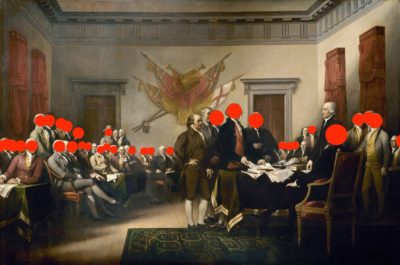
Collage made by Arlen Parsa using John Trumbull’s painting Declaration of Independence, 1818.
But the actions we see right now did not suddenly spring up from nowhere. For decades, various groups and movements have been asking for the removal of Confederate monuments, without much success.[2] This is why the direct action targeting statues of slave owners and dealers, Confederate generals and colonialists has become the BLM movement’s most popular tactic. At the same time, the removal of statues has become the main way through which groups in the west have expressed their solidarity with the movement.[3] Beyond the protests on every continent, it was when statues of colonialists and slave dealers began being taken down or covered in graffiti that antiracist solidarity reached a new level. The most notable examples are the removal of Edward Colston’s statue in Bristol, Robert Milligan’s in London, the graffitiing of Churchill’s statue in London, of colonial king Leopold II in Antwerp and Brussels (Belgium), of colonialist Piet Hein in Rotterdam (the Netherlands), of segregationist Paul Kruger in Pretoria (South Africa), and of imperialist explorer James Cook in Sydney (Australia).
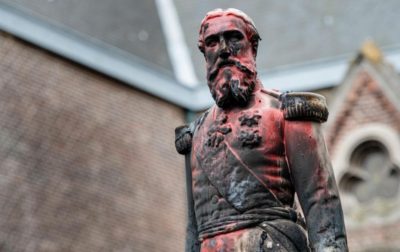
The statue of Leopold II is removed in Antwerp
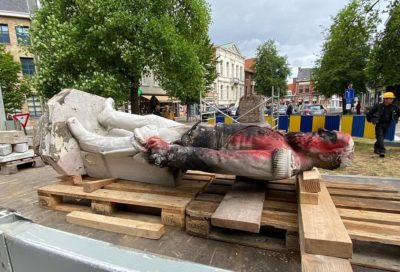
Credits: Belga
The way people in the west mobilized has demonstrated both the power of statues as symbols of oppression and the existence of an international antiracist sentiment. The statues of Colston, Churchill, and Leopold II do not just signify a bloody past which the west would prefer to sweep under the carpet. Generally, the role of a monument is to show the continuity of values and normative practices within a society. They reflect the dominant narrative about how that society came to be and what its values are. The fact that these enforcers of European colonialism have remained within western public spaces shows not just that western societies are not prepared to take responsibility for their historical role in genocide and pillaging, but also that these processes continue to this day through white supremacy and western dominance.
Why should the statues of colonialists, slave owners, and imperialist commanders from the Western world fall? Simply put, because they represent a world of exploitation and genocide. They stand for the western, white, capitalist world’s domination over all others. They are symbols of extreme violence, and their mere presence is a statement of white supremacy, as they legitimize colonialist and racist violence. And if these statues do not fall, their continued presence will become a threat that these kinds of violence could still take place today.
So the more relevant question is: why have they not fallen yet?
The answer is a long one. Less than 50 years ago, the European west was still waging bloody wars against natives in order to maintain its colonial dominance. The history that is taught in schools generally downplays the atrocities that took place in the colonies and how the wealth of western nations in the present is largely a result of the violent extraction of resources from the colonies. In contemporary European cities you can scarcely see a trace of commemoration for anti-colonial fighters, maybe a tiny bust somewhere or the name of a street far from the center. Material reparations are also far away from being even considered by governmental bodies. In fact, there are western European nations that still own colonial territories in, among other places, the Caribbean, the Pacific, and the African east coast.[4]
The great institutions of knowledge and so-called progress, that is, the western museums and universities, were funded by the wealthy colonial entrepreneurs. A good example is Oxford[5], One of the most prestigious universities in the world, which was financed with the help of English colonialist businessman Cecil Rhodes. On June 9, a large protest demanded the removal of his statue. It was not the first protest demanding this, but it was the largest to date. There have been many petitions throughout the years, but without much success.[6]
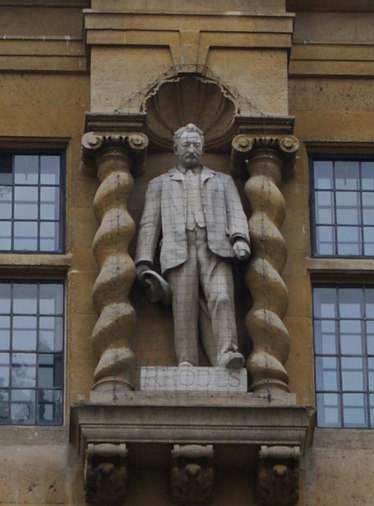
Cecil Rhodes at Oxford
Why we should dismantle the collections of ethnology and anthropology museums
Besides universities, there are other great western knowledge-producing institutions founded upon colonialist exploitation. The Louvre, the Quai Branly Museum, the British Museum, the Victoria and Albert Museum, and the Rijksmuseum, all have collections constituted from the plundering, manipulation, and intimidation of numerous African, Asian, and South American societies.[7] You might remember the scene from the movie Black Panther where Erik Killmonger walks through the Museum of Great Britain (a fictional equivalent of the British Museum) and, pointing towards an African artifact in the exhibition, bitterly asks, “How do you think your ancestors got these? You think they paid a fair price? Or did they take it, like they took everything else?” Behind these lines is an entire history of attempts to persuade these museums to return stolen indigenous items.[8] Also without much success.
The most popular case was the debate around returning the African artifacts in France.[9] Even though people have been demanding their return for decades, it was only with President Macron’s public speech in 2017 that it finally seemed this would become reality. “African heritage cannot be a prisoner of European museums,” was his official statement. His gesture sparked the writing of numerous policy proposals in multiple western countries. It also marked a turn away from the then-dominant philosophy of western museums, summarized in the 2002 declaration of “Universal Museums”: “Over time, objects so acquired – whether by purchase, gift, or partage – have become part of the museums that have cared for them, and by extension part of the heritage of the nations which house them.”
So the next time we see the statue of some colonial official, some slave owner or dealer, towering over some public square in Britain, France, or the Netherlands, we can weight it together with all the tens of thousands of artifacts looted from colonies, then defiled, monetized, and exhibited in western museums. For each statue of a colonialist there are thousands of artifacts that have been stolen from the societies they attacked, ransacked, and exploited. Their statues must fall and the artifacts returned. And this should be only the beginning of a far-reaching process of redistribution.
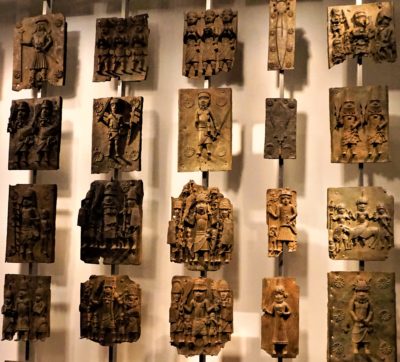
Bronze artifacts from Benin exhibited at the British Museum
The Emperor Has no Clothes
Wherever you are, in the west or anywhere else – even here in Romania – mourning the loss of such statues means speaking from a place of power, from that of an authority that sees its continuity threatened. An authority that fears its legitimacy, naturalized through centuries of hegemony, is finally challenged. In the end, felling or vandalizing a statue produces the naked emperor effect. Authority is based on the naturalization of certain social and cultural constructs plus the willingness of enough people to “believe” in the validity of these constructs without questioning them. It is only when a group begins questioning them, going so far as to take radical action against them, that the emperor is revealed as naked. You can see that he is not a god, that he is not superior to you, that he is just a man. In the same way, the toppling of statues shows us the naked emperor: the white western hegemony that normalizes the continuing exploitation of non-western lands, armed intervention when they are not “civilized” enough, and the criminalization of non-white bodies from within and without western borders. The superiority of western civilization is an illusion, and the toppling of statues is a fundamental gesture towards shattering its dominion.
Toppling a statue representing this kind of supremacy is a concrete act stemming from a radical vision dreaming of the utopia of an anti-imperialist, anti racist world, a vision where a better world is possible, one without such monuments. And this imagination has a strong continuity, beyond the present moment and beyond the borders of western societies. The emperor has been naked for a long time, and various forces have been constantly exposing his nakedness and opposing his rule. Ever since colonial history began, there has been resistance. So, in a sense, the removal of statues in the European west is the belated manifestation of the anti-colonial resistance and critique coming from Algeria, Martinique, Granada, Guyana, Haiti, and many other regions. The removal of these statues by westerners is just the delayed echo of the demands of anti-colonialist figures like Toussaint Louverture, Frantz Fanon, Lolita Lebron, Amilcar Cabral, Leila Khaled, Walter Rodney, and Patrice Lumumba.
At the same time, we can place these recent movements into the larger context of the popular rebellions that started in 2019 in places from Chile to Japan.[10] During the protests in Chile, hundreds of statues were brought down, showing that the population had stopped believing in the authority of a ruling class that does not represent them.[11]
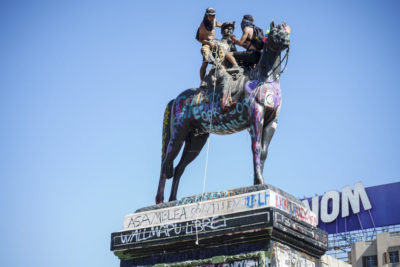
The beheading of General Baquedanoțs statue in the midst of protests in Chile in 2019. Credits: Camilo Vergara
A Lesson from the East
Some voices compared the toppling of statues now to the toppling of statues of Marx, Lenin, and other socialist and communist leaders after 1989. This analogy, however, is a mistake. And it is a mistake to compare them to any similar actions taking place after a regime change. There is a fundamental difference between how a new regime legitimizes itself by destroying the symbols of the previous one, and the actions of a social movement opposing a still-ruling order. The motivation behind the former is to assert a new ruling class, with radically different values and principles compared to the previous regime, while that behind the latter is about anti-state revolt when the government does not represent you.
Also, the removal of Marx’s or Tito’s busts marks the beginning of post-socialism where , neoliberal order reigns. This is a time when Eastern Europe became integrated , on a position of inferiority, into the global capitalist and neocolonial system. And this is part of the very global paradigm that BLM is fighting against. However, there is something to learn from viewing these two events side by side.
During the 1989 Revolution, the workers at the Electrobanat and IMGB factories[12] destroyed the portraits of Ceaușescu from their workplace and cut out the coat of arms from the national flag, creating the revolutionary flag. These were indeed moments of anti-authoritarian and anti-state rebellion with the potential of building up towards the seizing of power by the workers. However, they were quickly appropriated by the new pro-capital power, snuffed out by the neoliberal hegemony and the assimilation processes into global financial flows, while all the while signaling the victory of the western right. The anti-authoritarian drive and the vision of a more equitable society at the core of the factory riots were hijacked, made to stand for something else: the desire to be part of white western civilization at any cost.
Today, too, there is the risk that BLM’s iconoclasm will be appropriated towards a kind of polite liberalism. Beyond the reactions criminalizing the toppling of statues, calling it “vandalism” or “barbarism” (pejorative terms that, unsurprisingly, also have a colonial history behind them), there is the risk that these actions will only lead to moderate institutional reforms (for universities, museums, etc.). These would likely only be superficial, like making some corrections to the historical narrative or some tentative self-reflections on the origin of western institutions. But if we really want to listen to BLM voices, we must realize that the time for corrections and self-reflection has long passed. As we watch statues fall and autonomous zones being set up,[13] what we are seeing is two strong, concrete demands being made: the redistribution of resources that most do not have access to and the full responsibility for the role of colonialism and slavery in the west’s accumulation of wealth.
What Solidarity Should We Expect from the East?
The position of Eastern Europe on the map of this new anti-colonial struggle is rather next to the exploited peripheries and semi-peripheries. However, like in most of these societies, there is always a class that has access to resources and power and that is profoundly complicit with western imperialist structures. In Romania, this class was complicit in perpetuating the systems of serfdom and slavery, the signing of economically damaging treaties, entering abusive military alliances, and, most importantly, the carrying out of genocide against the Jewish and Roma population between 1937 and 1944.
The racism that led to these events did not simply go away after the war. Rather, it assumed different forms, as it is still at the root of many systemic injustices. The post-1989 anti-authoritarian struggles for Roma rights or housing rights have exposed the mechanisms of this historical and structural racism, as well as the ways we can fight it.[14] Certain misguided voices[15] in Romania have ridiculed the tactic of statue toppling in the context of BLM, ironically asking if we should also remove Ottoman symbols or the statues of slave-owning rulers from the pre-modern age. The refusal to see just how serious local racism is only shows how much we need such antiracist solidarity.
Romanian antiracist solidarity with BLM first manifested first and foremost through a direct action in Bucharest, which asserted both the legitimacy of the US movement and its connection to the local anti racist struggle.[16]
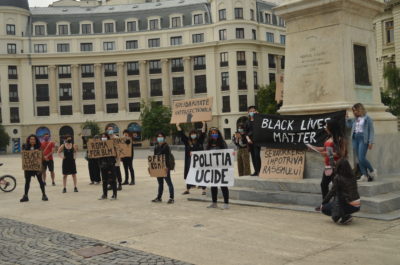
BLM protest in Bucharest
One way this could be continued is by calling out, loudly and clearly, all the murderers who contributed to these genocides and whose statues still stand. Politicians like Miron Cristea and Octavian Goga, but also intellectuals like Mircea Vulcănescu still have statues in public squares, showing the complete unwillingness of the ruling class to condemn their complicity in genocide. And, while we reflect on what is to be done with these statues, we can look at the few existing monuments to freedom fighters. One example is the 1907 statuary group, installed in a central location within Obor Market, then moved to Pantelimon Park to deliberately reduce its visibility.[17] This twofold recognition is both radical and intersectional.
An ironic cartoon “warns us” that whenever the figure of a colonialist falls, a bust of Marx comes to the surface.
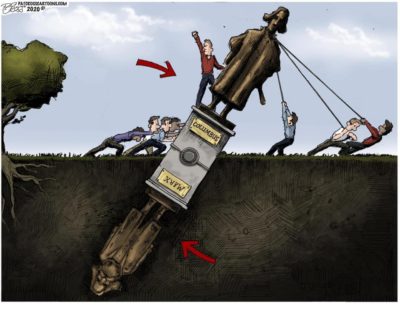
Though that wouldn’t be too bad, it is imprecise. The age signaled by antiracist, anticapitalist, and anticolonial radicalism is one where the colonialist’s bust is not replaced with anything, where the display cases in museums are emptied. And that is because the west would become quiet, learn to listen, and engage in a process of redistribution.
Translated by Rareș Grozea
[1] You can watch most of them being removed here.
[2] See a detailed map of the hundreds of confederate monuments in the US here.
[3] Rübner Hansen, Bue. 2020. “The universal truth of Black Lives Matter — a view from Europe,” ROAR Magazine, 14 June 2020.
[4] Boatcă, Manuela. 2019. Forgotten Europes.
[5] See the Oxford and Empire project.
[6] Reddie, Anthony G. 2020. “Kick Over the Statues” The Left Berlin, 8 June 2020.
[7] See, for example, Rooney, Paige. 2019. “A 21st Century Empire: The British Museum and its Imperial Legacies,” The Forum: Journal of History: Vol. 11 : Iss. 1 , Article 11.
[8] Hunt, Tristam. 2019. “Should museums return their colonial artefacts?” The Guardian, 29 June 2019.
[9] See Sarr, Felwine and Bénédicte Savoy. 2018. The Restitution of African Cultural Heritage. Toward a New Relational Ethics. See also the whole issue of Third Text, vol. 33, 2019, no. 4-5.
[10] Redacția Pagini Libere, 2020. “Despre proteste, revolte și țapi ispășitori”. 11 June 2020, Pagini Libere Publishing House.
[11] Information about the taking down of monuments in Chile in 2019 available here and here.
[12] Electrobanat is former state-owned company producing lighting objects from Timișoara. IMGB – Întreprinderea de Mașini Grele București is a former state-owned company producing heavy machinery from Bucharest. Both companies are notorious for their workers actively participating in the riots and revolutionary events of December 1989 in Romania.
[13] Read, Bridget. 2020. “What’s Going On in CHAZ, the Seattle Autonomous Zone?” The Cut, 23 June 2020.
[14] Dorobanțu, Oana and Carmen Gheorghe (eds.). 2019. Problema Românească – O analiză a rasismului românesc. Editura Hecate, Bucharest.
[15] See for instance Oprea, Marius. 2020. “George Washington a căzut.” Mediafax, 20 June 2020.
POSTED BY
Veda Popovici
Veda Popovici (b. 1986, Timisoara, Romania) works as a political artist, engaged theorist and local activist. Her interests include identity representations in art, intelectual genealogies of power, c...
veda-popovici.blogspot.ro/


Comments are closed here.